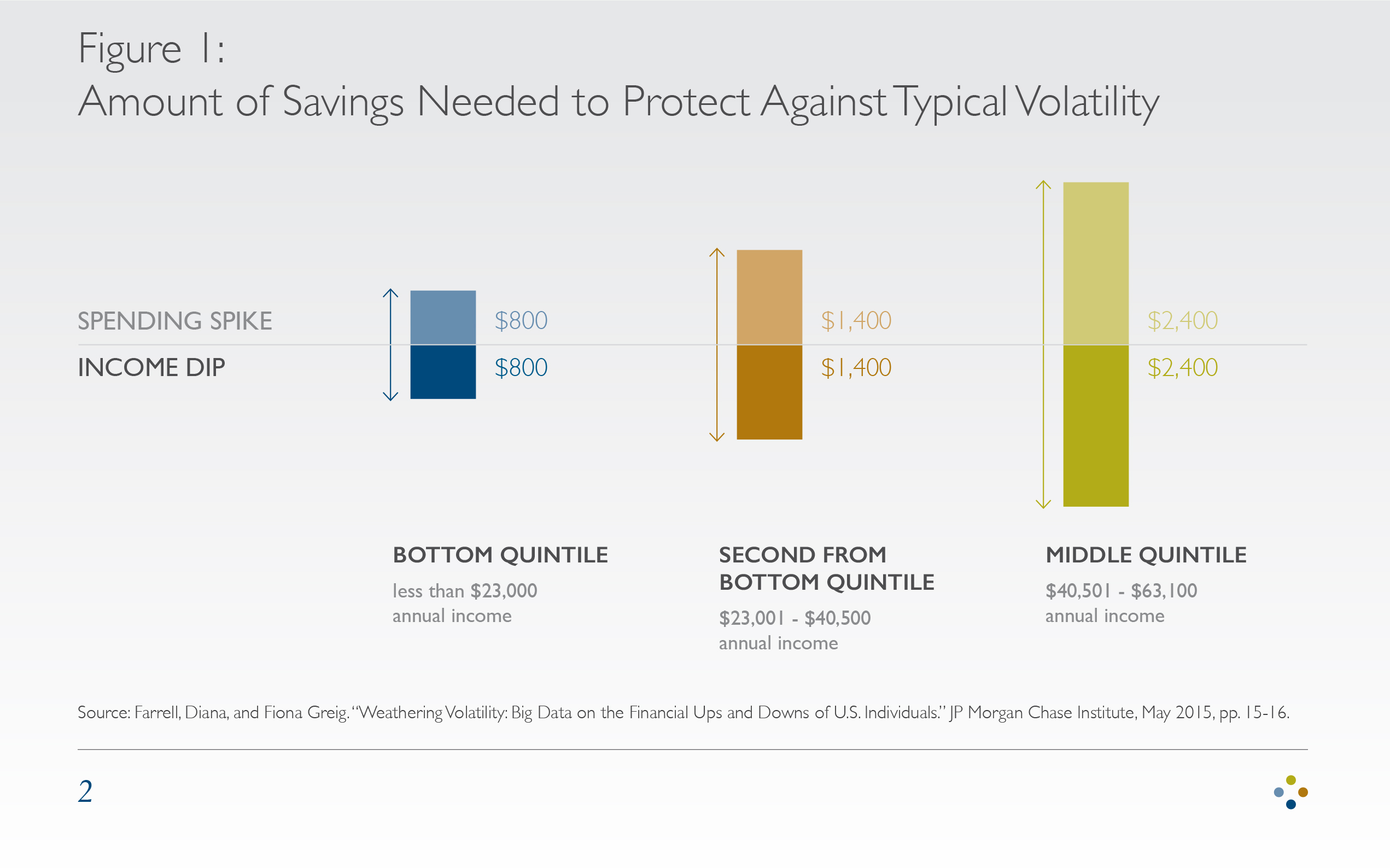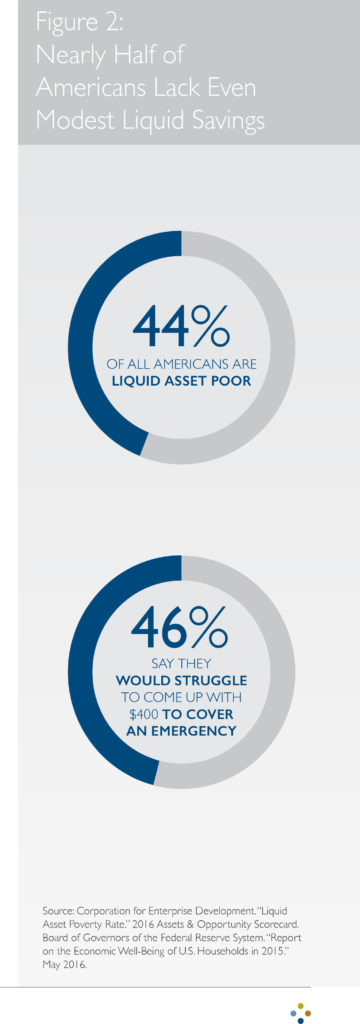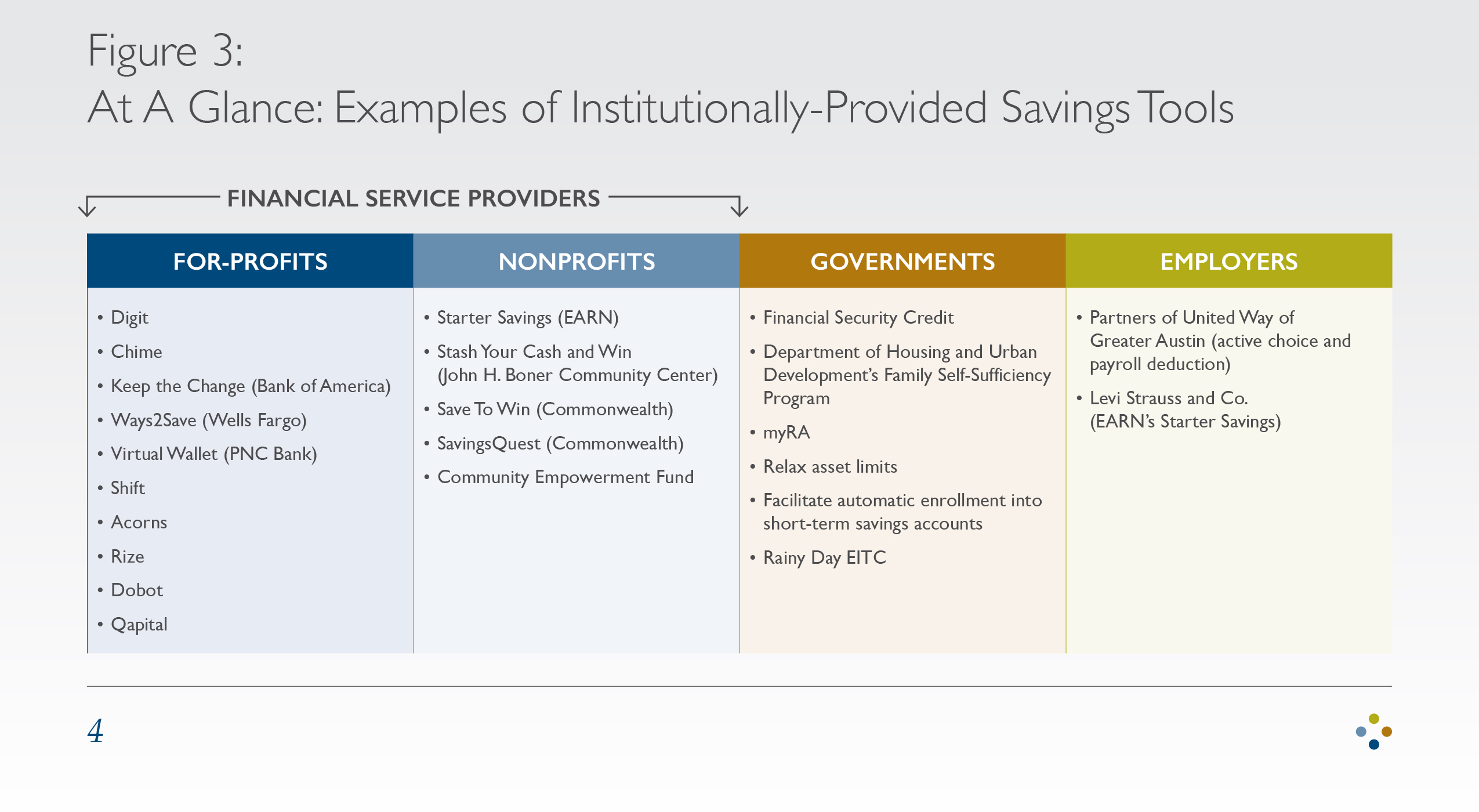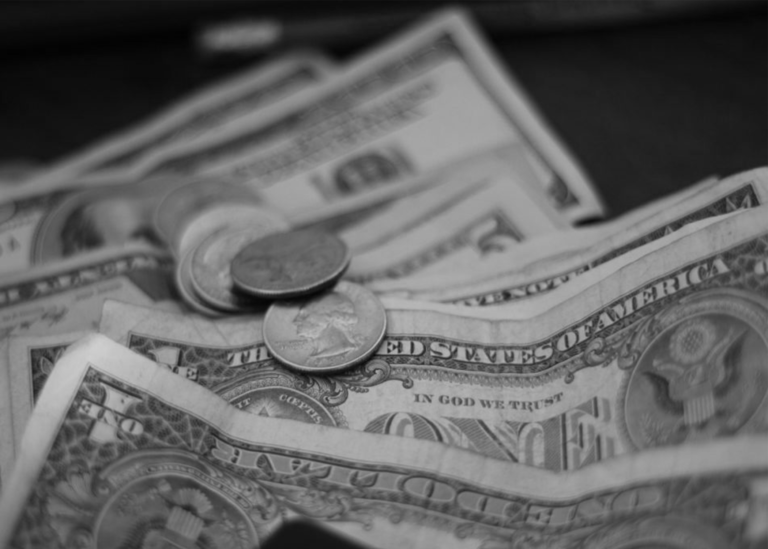●●●●
● Summary
EPIC has identified shortfall savings as a key tool in the toolbox for achieving financial stability. Without resources to tap into when in- come drops or expenses rise, families are left with few options for making ends meet. This brief explores the ways in which governments, for- and non-profit financial service providers, and employers can help low- and moderate-income households build savings for the short-term, which will help them smooth out the inevitable spikes and dips in their income and expenses.
● Background
The Expanding Prosperity Impact Collaborative (EPIC), an initiative of the Aspen Institute’s Financial Security Program, is a first-of-its-kind, cross-sector effort to shine a light on economic forces that severely impact the financial security of millions of Americans. EPIC deeply investigates one consequential consumer finance issue at a time.
EPIC’s first issue is income volatility, which destabilizes the budgets of nearly half of American households. Over the last year, EPIC has synthesized data, polled consumers, surveyed experts, published reports, and convened leaders, all to build a more accurate understanding of how income volatility affects low- and moderate-income families and how best to combat the most destabilizing dimensions of the problem.
This brief is part of a series that explores highly promising solutions to income volatility. This report focuses on shortfall savings, the financial resources families need to cope with short-term income and expense volatility. Our hope is that the analysis that follows will push financial service providers, employers, and governments to consider ways to help consumers build this vital buffer against the vagaries of today’s economy.
● Issue Brief
THE POWER OF A SAVINGS BUFFER TO MITIGATE VOLATILITY
A number of studies have shown that even a small amount of savings can reduce the burden on households from financial shocks. An Urban Institute study found that having liquid assets, even if less than $2,000, is associated with lower incidence of various financial hardships, such as missed payments, foregone medical care, and food insecurity. A separate study found that families with non-retirement savings of between $250 and $749 are less likely to be evicted, miss a housing or utility payment, or receive public benefits when income disruptions occur.
These families are practicing what economists call “consumption smoothing” – the ability to even out the purchase of necessities over time despite fluctuating income. And not surprisingly, people who have more wealth – or can access wealth through family and social networks – can more easily smooth consumption. By one count, changes in consumption caused by income volatility were three times greater for individuals with low wealth and low family wealth than for those with high wealth and high family wealth. This can mean the difference between families paying bills on time and having utilities shut off, or the difference between eating a nutritious diet and foregoing meals.
Expense volatility caused by medical emergencies, car repairs, or other costs, complicates this picture somewhat. Using customers’ anonymized transaction data, the JPMorgan Chase Institute found that households in the bottom income quintile (less than $23,300 in annual income) need $800 in savings to be able to safely absorb a typical consumption shock. This is in addition to the $800 these researchers estimate low-income families need to be able to cope with an income dip. Given that the JPMorgan Chase Institute also found that income and consumption swings often do not move in tandem, this means low-income families should have $1,600 on hand should they want to be able to keep their income and spending on an even keel during a particularly bad month. The corresponding figure for those families in the second lowest income quintile (between $23,301 and $40,500 in annual income) is $2,800, and it is $4,800 for those in the middle quintile (between $40,501 and $63,100).
OPPORTUNITY FOR – AND BARRIERS TO – IMPROVEMENT
Despite the compelling evidence above, few families have enough savings to effectively smooth income and consumption. Nearly half of all Americans are liquid asset poor, meaning they do not have enough readily accessible savings to live above the poverty line for three months should they face an income disruption. Nearly half say they would struggle to come up with $400 to cover an emergency. The U.S. Financial Diaries (USFD), an in-depth study of 235 low- and moderate-income (LMI) families’ day-to-day finances, observed that only 7% of their sample met their emergency savings goals, and 50% had no precautionary savings at all.

Conceptions of “emergency savings” being tapped only on rare occasions (e.g., job loss, medical crisis) are likely outdated. In a volatile financial world, households must use their savings much more regularly to stay afloat.

This is not to say that LMI households are not saving, at least over short periods of time. For example, the households who participated in USFD research saved, on average, 17% of their income, putting three times more into savings than their year-end savings balance would suggest. This means that families were putting money aside, but that they drew on the funds regularly. Of course, this is not necessarily a bad thing, but highlights the fact that previous conceptions of “emergency savings” being tapped only on rare occasions (e.g., job loss, medical crisis) are likely outdated. In a volatile financial world, households must use their savings much more regularly to stay afloat. Still, four out of five households in Pew’s Survey of American Family Finances had lower savings than what they think similar households should have.
There are several reasons households don’t save as much as they would like. For one thing, predicting future expenses, even in the most stable environments, is hard. As previous EPIC work has shown, not knowing how much money will be coming in one week to the next – one of income volatility’s defining features – makes deciding how much to save even more challenging. For example, one study found that households in the lowest income quintile believed they had annual emergency savings needs of $1,500 while the amount those households typically spent on unexpected expenses was 33% higher at around $2,000.
There are also a number of well-known psychological barriers to saving. Stated simply, humans tend to overvalue the present and are overly optimistic about the future, which tempts us to spend money now and put off decisions about the future.
Economists often point to today’s historically low interest rates as another factor that reduce the amount families will save, though even in a high interest-rate environment, banks are unlikely to offer high rates of return on the type of small-dollar, short-term, emergency accounts that we are interested in here. Finally, stagnating real wages – simply not having enough money to meet current expenses – are another potential culprit; though this explanation is belied in part by the successful attempts to help LMI Americans build savings highlighted below.
HOW INSTITUTIONS CAN HELP
FINANCIAL SERVICE PROVIDERS
When a group of experts was asked how financial innovation could help families reduce or mitigate their income volatility, “savings tools” was the second most popular response (after hybrid products, which is the subject of a separate brief). Savings tools can help people automatically save when income jumps above average, or can use behavioral nudges, such as text or email reminders, to convince consumers to save in the moment. Many in the private market – both for-profits and not-for-profits – are experimenting with new tools, products, and account structures to overcome the barriers outlined above and make saving attractive and accessible to all.
FOR-PROFITS
Digit –This San Francisco-based start-up makes saving effortless and out-of-sight by studying its customers’ spending and income history to determine a safe amount of money to automatically transfer from a checking to a savings account every two or three days. If Digit gets it wrong and forces customers into an overdraft, they’ll cover the fee the first two times it happens. The savings accumulate in an FDIC-insured, white-labeled Wells Fargo account and can be withdrawn at any time, though it takes one business day to get it back into the customer’s checking account. The Digit account does not pay interest, though customers receive a 0.25% “Savings Bonus” every three months based on their average balance over that time period. The product uses text messages to update users on their progress and, as of April 2017, charges $2.99 per month after a trial period. It had previously been free. Customers must have a bank account to join and have mostly been middle income ($50,000-$60,000 average annual income). It is the most mature of the growing number of savings apps in the market, having raised over $36 million from investors since its founding in 2014, helped customers save $125 million since opening to the public in 2015, and participated in a previous round of JPMorgan Chase’s Financial Solutions Lab.

Chime – Another San Francisco-based startup, Chime is a “mobile-first,” fee-free bank account that encourages saving through weekly bonuses and rounding up debit card transactions to the nearest dollar and depositing the difference into a savings account. This makes savings easier because the amounts feel small relative to a large, lump-sum transfer. By 2016, three years after being founded, Chime had raised $21 million in venture capital funding. In 2017, they will be partnering with Common Cents Lab to better serve low-income consumers.
Bank of America – Lean start-ups aren’t the only ones pursuing innovative savings tools. In 2005, this mainline financial institution launched “Keep the Change,” which, like Chime, rounds up debit card transactions and saves the difference. There had originally been a match, but that feature is no longer offered to new enrollees. In its first year, 2.5 million customers signed up.
Wells Fargo offers similar functionality through its “Ways2Save” program, which moves $1 from checking to savings each time the customer makes a debit card purchase, pays a bill online, or makes an automatic payment.
PNC Bank – This large bank has incorporated a number of innovative savings tools into its “Virtual Wallet,” which combines checking, short-term savings, and long-term savings accounts into one, user-friendly interface. The “Savings Engine” component of the account allows customers to direct a predetermined amount of money to automatically transfer from checking to long-term savings on payday. And the “Punch the Pig” feature makes moving money from checking to savings as fun and easy as shaking your smartphone. Within five years of being launched in 2008, it surpassed one million accounts.
An increasingly crowded space: Making savings sexy has become something of a cottage industry in recent years, with many start-ups joining the scene. While the ones highlighted above are the furthest along, many of the new entrants below have shown promise. Seeing as most of these products target upwardly mobile millennial customers, it remains to be seen if they can also reach financially vulnerable families:
- Chicago-based Shift (formerly Milo) rounds up transactions to the nearest full dollar and saves the difference. In addition to selling directly to consumers, it also sells a version of the product to employers – to be used as an employee benefit – for $3 or less per employee per month.
- Acorns uses a similar method, but invests the rounded-up proceeds into a diversified portfolio of stocks and bonds (for a $1/month fee).
- DC-based Rize helps millennials save towards specific goals by automatically transferring a flat monthly amount into an interest-bearing brokerage account.
- Dobot works similarly to Digit, but the automatic transfers are always once a week, rather than every few days, and users can pause the program indefinitely, whereas Digit will reactivate automatically after a pause.
- New York-based Qapital empowers consumers to set up “Rules” that allow automatic savings under certain, user-determined circumstances, like when the user spends on an indulgence, goes to the gym, or when it’s sunny outside.
NONPROFITS
EARN – In October 2016, this national nonprofit launched an online savings platform called “Starter Savings” to facilitate “microsaving” for emergencies. The program partners with other nonprofit service providers (e.g., Neighborworks America) and has links to 15 major financial institutions (e.g., Capital One 360 and US Bank) to provide matching payments ($10 for every $20 saved for six months) to small-dollar savers. EARN’s proprietary platform is currently being used by over 30,000 low-income consumers in all 50 states. EARN recently received a sizeable grant from the W.K. Kellogg Foundation for the explicit purpose of “address[ing] the destabilizing effects of income volatility” through flexible savings. The two-year project will include a study of EARN’s clients’ experiences with volatility, as well as development of a new savings product to meet the challenge of volatility head-on.
John H. Boner Community Center – In order to help its clients build a savings cushion, this Indianapolis-based Individual Development Account provider launched “Stash Your Cash and Win,” a six-month prize-linked savings pilot that was combined with a financial education class. The program was popular: 75 out of 80 eligible savers opened accounts, and 74 out of 75 account holders made at least one $25 deposit, which qualified them for one raffle entry for a once-a- month $100 prize.
Commonwealth – There is growing evidence that prize-linked savings programs like the Boner Center’s are an effective way to motivate otherwise cash-strapped families to save. The nonprofit Commonwealth (formerly Doorways to Dreams Fund) has spearheaded this work, partnering with credit unions across the country to launch “Save to Win,” a large-scale pilot program that infuses the adrenaline and instant gratification of the lottery into the normally mundane task of saving. Instead of interest, savers, in exchange for their deposits, receive entry into a raffle for cash prizes. To date, credit unions in seven states have participated, helping 60,000 LMI consumers save $140 million. Commonwealth has also experimented with gamification, which attempts to make saving – and other tedious financial tasks – feel like a fun, competitive game. Like fitness tracker Fitbit, Commonwealth’s “SavingsQuest” gives users badges, points, and other tokens of encouragement to reward good behavior.
Community Empowerment Fund (CEF) –This North Carolina-based nonprofit helps individuals escape homelessness through workforce development, financial education, and matched savings accounts. To boost savings, CEF gives its clients a punch-card so that they can physically track – and get positive reinforcement – as they progress towards their savings goals. According to an analysis by Common Cents Lab, the punch-cards made savers 16% more likely to be on track to reach their goal.
Some companies are offering savings solutions as part of other financial products, like prepaid cards. For example, American Express’s prepaid card Serve has a set-aside feature called "Reserve", and Walmart has partnered with Green Dot and Commonwealth to institute a prize-linked savings incentive program called "Prize Savings" as part of its prepaid card’s savings pocket, MoneyCard Vault. For more information on these products, see EPIC’s brief on hybrid products.
GOVERNMENTS
Federal, state, and local governments play many roles, all of which can be harnessed to facilitate shortfall savings.
Regulator – Federal and state governments can shape what types of savings accounts are offered to the public through their role as regulators of financial institutions. Governments can also choose to relax regulations in order to spur innovation. For example, as the sole regulator of employer-sponsored retirement accounts, the federal government could sanction – or facilitate experimentation with – automatic enrollment in “sidecar” savings accounts, an emergency fund that would be offered as a complement to a traditional retirement plan.
Incentivizer – The federal government spends over $170 billion each year subsidizing long-term savings in the form of tax-preferred retirement accounts like 401(k)s. However, no similar incentive exists today for short-term savings. While it is unclear if the public investment in long-term accounts actually spurs much new net savings, there are a number of proposals that would incentivize short-term savings through the tax code as well. New America, for example, has proposed a refundable tax credit called the Financial Security Credit or Saver’s Bonus, which is tied to contributions made to a range of savings options, including readily-accessible liquid accounts.
Public Benefit Provider – Public benefit programs like Supplemental Nutrition Assistance Program (SNAP),Temporary Assistance for Needy Families (TANF), Earned Income Tax Credit (EITC), and housing subsidies can interact with and shape beneficiaries’ short-term savings decisions in several ways. Most directly, these programs can be structured to build savings. For example, the Department of Housing and Urban Development’s Family Self-Sufficiency (FSS) Program gives local housing authorities the option of allowing public housing residents to save any increases in earnings in a matched account. This is a strong incentive, not just because of the match, but because public housing residents pay rent as a proportion of income, so usually earning more means paying more rent. Another idea in this vein is the Rainy Day EITC, which would give EITC beneficiaries the option of getting 20% of their tax refund, plus interest, six months after tax season, instead of in one lump sum. Asset limits used to determine eligibility for SNAP and TANF should also be reconsidered, since they discourage savings and send the wrong message to low- and moderate-income households. Forcing families – both current public benefit recipients and potential future beneficiaries – to sell their cars or spend down their modest savings in order to become eligible for benefits has been shown to lower savings and decrease bank account ownership rates.
Account Provider – Less traditionally, the government could serve as an account provider of last resort, stepping into market gaps to ensure universal access to safe and affordable short-term savings vehicles. The most prominent example of this from recent years is the Treasury Department’s myRA ,a no-fee, government-backed savings account. Though technically a retirement savings instrument – and targeted at those without access to a retirement plan through their employer – its post-tax Roth structure means there is no penalty for withdrawing contributions at any time. That, plus a $15,000 maximum balance and a 2%+ interest rate, has led some to argue that myRA is an ideal emergency savings account. However, withdrawals can take a number of days to reach the customer’s checking account, which limits liquidity and could be a problem in the case of an actual emergency.
Short- and long-term savings could also come in the form of a mandatory social insurance scheme to complement Unemployment Insurance (UI) or Worker’s Compensation. For example, several policymakers and advocates have proposed payroll-funded, tax-advantaged personal accounts to support job seekers. For more on those proposals, see EPIC’s brief on reforming UI.
EMPLOYERS
The relative success of the employer-based retirement system – about half of Americans have a plan through work and trillions of dollars in assets have been saved – proves that the employer delivery channel, if harnessed properly, could be useful in scaling a new shortfall savings system. Already, a few employers have recognized the value of helping their workers save not just for retirement or for large health care expenses, but also more run-of-the-mill, short-term financial needs:
Partners of UnitedWay of GreaterAustin (UWATX) – UWATX created an automatic savings program for its partner organizations’ employees. Workers are given the option of setting aside a portion of their paycheck into a savings account, which can be opened for them on-site. To sign up, workers attend an in-person meeting and complete a simplified direct deposit form. An analysis of a pilot of the program found it to be both effective and scalable.
Levi Strauss & Co. –This clothing retailer’s nonprofit arm, the RedTab Foundation, has partnered with EARN to provide a shortfall savings program to Levi’s hourly employees. Like other EARN projects, enrollees link to the program from one of the supported banks and credit unions and, once they start saving, become eligible for a match, in this case $1 for every $1 they save, up to $40 each month for six months. If participants save at least $10 every month for all six months, they’ll get an extra $20 at the end of the program. In the first year, 32 employees saved $16,750 of their own money.
For more on the power of the “payday” moment, the opportunity presented by “five Friday” months, and the importance of automatic payroll deduction, see EPIC’s brief on payroll innovation.
PRINCIPLES FOR FUTURE REFORM
No matter which institution is taking action to help families build shortfall savings, there are a number of best practices and key considerations to keep in mind.
Defaults are the most powerful nudges. Framing, commitment devices, peer-comparisons, reminders, and matches can all be effective at boosting savings – as numerous experiments have shown. But to really move the needle, there is simply no comparison to opt-out automatic enrollment. This is especially true for the busiest and most financially stressed among us, who are unlikely to find the time and cognitive bandwidth to set up a shortfall savings account on their own, but who would also likely benefit the most from having such an account. Of course, there are challenges to this approach. For example, employers are unlikely to automatically enroll their workers in a short-term savings account – and risk running afoul of state anti-garnishment laws – without the explicit blessing of the federal government. And for those in non-traditional work arrangements, especially those who have no official “employer” (e.g., independent contractors), the onus for signing up for savings programs, at least under the current system, falls to the worker.
Carefully balance liquidity. Perhaps the most pressing design question for administrators of savings programs – other than automatic enrollment– is how easily savers will be allowed to access their accumulated funds. Savers themselves are of two minds: they are unlikely to sign up for a savings program if they don’t have some assurance that they will be able to get to their money in an emergency; but they also express a preference for some liquidity restrictions so that they can resist day-to-day spending temptations (or the temptation to help friends or family members in a financial bind who come to them for help). Evidence suggests that making withdrawals from a savings account even slightly inconvenient (e.g., creating “friction” like a one- or two- day waiting period or increasing the necessary paperwork for a withdrawal) can do the trick, but further research is needed.
Small dollars can have big impacts. Saving only a few dollars (or, in the case of round-up products, a few cents) at a time can mean very slow accumulation and very low balances. Some have questioned the utility of an account with only a few dozen dollars in it, not to mention the administrative expense borne by the financial institution of servicing such a small dollar account. But every dollar saved is one that doesn’t have to be borrowed should families hit a financial rough patch. This should give workers struggling with income or expense volatility at least some peace of mind. Plus, research shows that small balances can have an outsized, positive impact on financial health. So, savers should not be discouraged by small balances and innovators should continue to leverage technology to make such accounts as costless to administer as possible.
Data integration is the future. As Digit and other fintech firms have shown, “smart” savings tools that work in the background of our lives and know what we can afford to save are within our reach and could be quite powerful. But those algorithms are only as useful as the data they have access to. As long as Americans continue to live fragmented financial lives – for example, with a checking account and debit card from one bank, a prepaid card and retirement account from work, and a savings account and mortgage from the local credit union – the most valuable tools will be the ones that integrate and aggregate data across these platforms. It’s no wonder then that financial data-sharing companies like Yodlee and Plaid are seeing a surge in business and that fintech companies like Personal Capital and Intuit are negotiating with data-rich financial institutions around how to access their customers’ records. The Dodd-Frank Wall Street Reform and Consumer Protection Act required that banks make machine-readable records available to consumers on demand, which could reshape how consumer data is accessed, but the federal regulation that effectuates that provision is still pending. While security is of course a concern, the more easily consumers can share their own financial data with vendors of their choice, the better their short-term savings options will be.
Shortfall savings build a financial cushion that helps families relieve liquidity crunches and enhance their overall economic resiliency. There is perhaps no more valuable tool in families’ fight to manage the reality of income and expense volatility. Thankfully, some of the country’s most innovative leaders from across the financial, technological, social, and government sectors have dedicated themselves to building smarter, more accessible savings tools and policies to meet this growing challenge.
Shortfall savings build a financial cushion that helps families relieve liquidity crunches and enhance their overall economic resiliency. There is perhaps no more valuable tool in families’ fight to manage the reality of income and expense volatility.
For Endnotes and Works Cited, please download the PDF version of this Issue Brief:
● Acknowledgments
EPIC would like to thank David Mitchell for writing this brief; Katherine Lucas McKay for coordinating the internal deliberative process resulting in this series of solution-focused issue briefs; Mariel Beasley, Colleen Briggs, Michael Collins, Kiese Hansen, Clinton Key, Justin King, Katherine Lucas McKay, Gracie Lynne, Leigh Phillips, Ida Rademacher, Anne Romatowski, Eric Showen, and Joanna Smith-Ramani for reviewing drafts and making invaluable suggestions; Pamela Chan, Arlyn Davich, Timothy Flacke, Fiona Greig, Dan Quan, Arjan Schutte, Steve Utkus, and Megan Wong for the time and wisdom they shared on the topic; and Laura Starita at Sona Partners for designing the template that was used to layout this brief. EPIC would also like to thank all those who completed the expert surveys or participated in EPIC’s many income volatility-focused convenings. While this document draws on insights shared at these EPIC forums and by the aforementioned individuals, the findings, interpretations, and conclusions expressed in this report – as well as any errors – are EPIC’s alone and do not necessarily represent the view of EPIC’s funders or Advisory Group members. Finally, EPIC thanks the Citi Foundation, the Ford Foundation, and the W.K. Kellogg Foundation for their generous support.
●●●●
●●●●
EPIC is an initiative of the Aspen Institute's Financial Security Program.
CONTACT US:
The Aspen Institute
2300 N Street, NW Suite 700, Washington, DC 20037© The Aspen Institute 2017—All Rights Reserved





